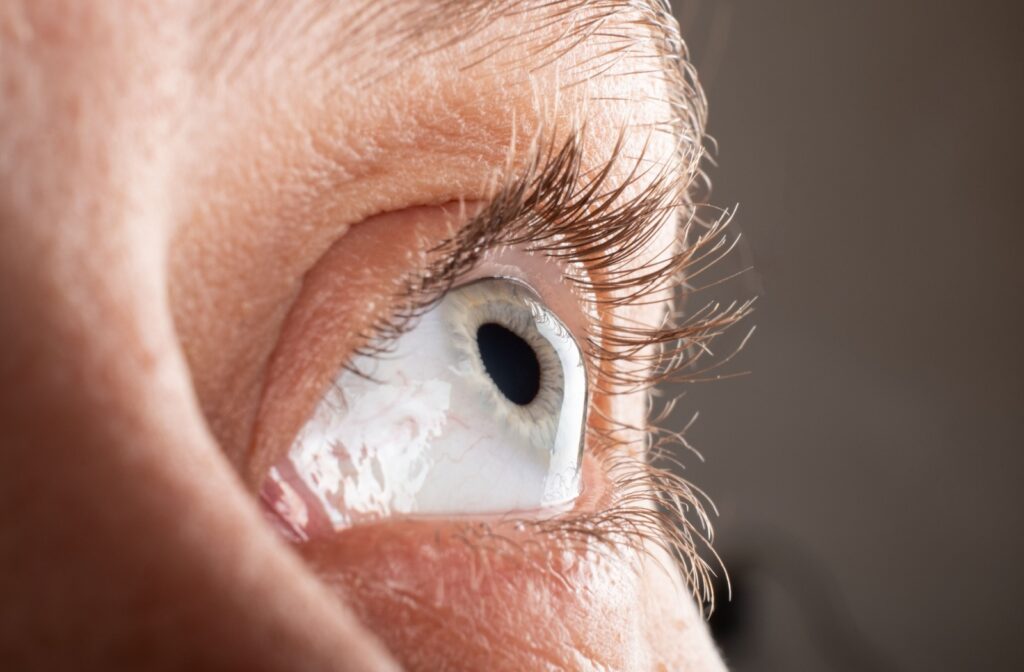Imagine looking through a windshield warped by a heavy rainstorm. For those with keratoconus, this distorted view is a daily reality. Keratoconus is a progressive eye condition that affects the cornea, leading to vision impairment.
But what causes this condition? Research suggests that keratoconus may have a genetic component, as it often runs in families. However, environmental factors, such as excessive eye rubbing, allergies, and exposure to ultraviolet light, may also contribute to its onset and progression.
The best way to find out if you’re experiencing keratoconus is to get an eye exam.
What Is Keratoconus?
Keratoconus is a condition in which the cornea—the dome-shaped surface at the front of the eye— gradually thins and bulges outward into a cone-like shape. This abnormal shape deflects light as it enters the eye, causing distorted vision.
Keratoconus a progressive disorder, meaning that it worsens over time. It often starts in the teenage years and stabilizes sometime in your 30s.
How Does Keratoconus Affect the Eyes?
The primary effect of keratoconus is a significant change in vision. The cone-shaped cornea causes light to scatter and creates multiple images on the retina, leading to blurred and distorted vision.
Patients may also experience glare, increased sensitivity to light, and difficulty seeing at night. In advanced cases, the cornea can scar, further degrading quality of vision.
The Genetic Link to Keratoconus
Research indicates that keratoconus has a genetic component, but it’s not purely hereditary. While having a family member with keratoconus increases your risk of developing it, the condition doesn’t follow a straightforward inheritance pattern.
This suggests that multiple genes and environmental factors likely contribute to the development of keratoconus.
Other Potential Causes of Keratoconus
Environmental Influences on Keratoconus
Environmental factors also play a significant role in the onset and progression of keratoconus, including:
- Chronic eye rubbing
- Allergies
- Exposure to ultraviolet (UV) light
Eye rubbing, in particular, can physically alter the shape of the cornea, accelerating the process of thinning and bulging.
How Lifestyle Choices Can Impact Keratoconus
Certain lifestyle choices can mitigate or worsen symptoms. Protecting your eyes from UV light by wearing sunglasses, avoiding eye rubbing, and managing allergies can help slow progression of the condition.
Maintaining overall eye health through a balanced diet and regular eye check-ups also plays a crucial role.
Diagnosing & Managing Keratoconus
Recognizing the Signs of Keratoconus
Early detection of keratoconus is vital for effective management. Signs to watch for include:
- Blurred or distorted vision
- Increased light sensitivity
- Frequent changes in eyeglass prescriptions
- Difficulty driving at night
If you notice any of these symptoms, consult an eye care professional as soon as possible.
Protecting Your Vision
Taking proactive steps to protect your vision is crucial for those with keratoconus. Regular eye exams, adhering to prescribed treatments, and avoiding activities that strain the eyes can help preserve visual acuity.
Additionally, using lubricating eye drops to manage dryness and avoiding allergens can reduce the urge to rub your eyes.
Treatment Options for Keratoconus
Treatment for keratoconus varies significantly depending on the severity of the condition and how it affects your vision.
Early Stages
In its early stages, the condition may be effectively managed with prescription glasses or soft contact lenses, both of which help to improve visual acuity and comfort.
Moderate States
As keratoconus progresses and the cornea becomes more irregularly shaped, more specialized corrective options become necessary.
Rigid gas permeable (RGP) lenses are often recommended, as they can provide sharper vision by creating a smooth refractive surface over the irregular cornea.
Advanced Stages
For those with more advanced keratoconus, scleral lenses or custom soft lenses may be required. These lenses offer improved comfort and vision by vaulting over the cornea and resting on the sclera.
In cases where keratoconus has reached an advanced stage, surgical interventions may become essential to restore vision and prevent further deterioration of the cornea.
Procedures such as corneal cross-linking can strengthen corneal tissue and halt the progression of the disease.
Other surgical options include INTACS inserts, which are small ring segments placed in the cornea to flatten its shape, and corneal transplants, where a damaged cornea is replaced with healthy donor tissue.
Each of these treatments aims to improve visual outcomes and enhance quality of life for individuals affected by this condition.
When to Get Tested for Keratoconus
If you have a family history of keratoconus or exhibit any symptoms, it’s important to get tested as early as possible.
An eye care professional will conduct a comprehensive eye exam, including corneal topography, to map the shape of your cornea and detect any abnormalities. Early diagnosis allows for timely intervention and better management of the condition.
Living with Keratoconus: What to Expect
Living with keratoconus requires ongoing management and regular check-ups to monitor the condition’s progression. Many patients can maintain a good quality of life with the right combination of treatments and lifestyle adjustments.
Monitor Your Eye Health
Keratoconus is a complex condition influenced by genetic and environmental factors. While there is no cure, early detection, and appropriate management can significantly improve the quality of life for those affected.
Understanding the signs, seeking timely medical advice, and adopting protective measures are key to preserving vision and maintaining eye health.If you or a loved one is at risk for keratoconus, book an appointment with Total Vision to discuss testing and treatment options. Remember, taking proactive steps today can make a world of difference tomorrow.



